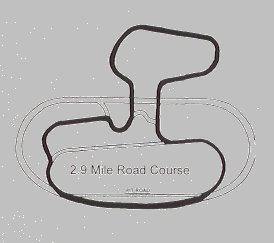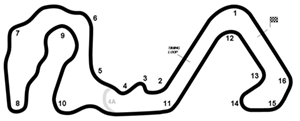Personality
The car you drive at the track is a reflection of your personality. I started thinking about this because of the dire importance of predictability in this sport.
When following another driver into a turn at high speed, you're very interested in what's going through that mind in the lead car, lest it be you. You can make certain predictions based on the car, but ultimately, you want to be inside their head enough to know when they will be braking or when they might spin. It's also true that the more you know about how someone thinks, the more you know about how to pass them in a race.
I began to observe the folks that I was around, and started to see patterns. Those roughly corresponded with vehicle types, kind of like owners kind of resemble their dogs.
To start off with, there is a LOT of ego on the track, especially in the more advanced run groups. At the very highest level (non-racing), it's not so bad, since those guys have been seeing the same faces for years, and they KNOW who is faster and who must give way.
A very good driver told me once "It's not about not having ego. Everyone here has a huge ego. It's about how you manage it". That management is reflected in the way the drivers drive, and thus makes them more predictable if you can find the patterns.
Here are a few personality types I've seen on the track (tongue firmly in cheek so as not to offend anyone).
The Giant Killer: Their car might not have alot of grunt, but their goal is to keep up with the big boys. Giant Killers often grow up into very very good drivers, because to run down a higher horsepower car is no mean feat. Typically found driving a Lotus Elise or Subaru STi or Mini-Cooper. If you are driving a high-horsepower car, don't be surprised if you find a Giant Killer lining up behind you in the grid, with a predatory smile. Giant Killers are predictable, momentum-centric drivers. They will hate to pull off line for passes, and may be reluctant to let higher horsepower cars pass them.
American Muscle: Most likely found driving a Corvette, Viper or Mustang. These folks have the horsepower to run away from anyone on the straights, and they know it. They will tend to close up on folks in the straights, and get caught in corners. Generally a little older than the Giant Killer, the Muscle guys are predictable straight liners. They can grow up into formidable drivers, if they can learn to use that power in the corners. More horsepower is actually equal to more options.
Rice, Rice Baby: There is a DVD in their Mitsubishi playing "The Fast and The Furious" while waiting in the grid. The car is running 20 pounds of boost, at 11 FAR. You can hear the blow off valve all the way across the track. The exhaust is a cavernous affair larger than a chinese apartment. Ricers are rare at track events. The courses are generally too long and their cars are tuned too hot. They are predictable in the sense that they are likely to spin if pushed. Lots of racing mentality in this culture, so lots of competitive spirit. They tend to be younger than the average HPDE driver, and thus might still consider themselves immortal. They will care a great deal about what's going on behind them, so be wary of the spin.
Money: The money guys are easy to spot: Look for the expensive trailer rig and the two cars (in case you just can't decide). Money guys are just like you and me, but with more cash on hand. Some of them tend to be extra-careful about their cars, and thus can be counted on to not take undue risks. Some (the ones that have BIG bucks) just don't care. They will sling a quarter million dollar Lambo into the weeds like it was a stolen Prelude. Talk to them, figure them out, becuase they often have cool stories! No way to know what they will think to do ontrack, save to observe.
Grrrrrrr!: Acronym for Grass Roots RRRRacing! Towed their '82 Spec Racer Rabbit to the track behind their bio-diesel truck. Ready to tell you how they spent $2.54 last year on tires. Racing on a budget is their game, the track time is their reward for playing it well. Preoccupied with prep and gear, they often turn slower times because they are not really optimizing for that. Talk to them to figure out how to make your pennies go further. Natural enemy of the Money racer above. Quite often found staring at the big trailer with the AC humming in the 108 degree paddock and grinding their teeth.
Mom and Pop: They drive in different groups, so they can use the same car. Sometimes one watches the kids while the other drives. Often, the car is a daily driver. Most likely will be conservative, though I know at least one pair that is very aggressive. Nice folk to talk to between run sessions, and most likely to have cookies in the pits. Never, ever underestimate the female half of this team.
Re-tired!: Two subtypes: Ex-racer and newbie. The ex-racer generally quit before you were writing cursive. Loads of info and things to learn, though may not be applicable to modern cars. Generally not too aggressive as they have nothing to prove to you. The newbie is retired and bought their dream car, then wanted to learn to drive it. Capable of doing any-damn-thing on the track, so watch from a discreet distance.
The Kid: Sent to the event by their parents, to make them better drivers. Often, the parents are along. If they are, The Kid will likely be subdued, even cautious. If not, or it's their second session, watch out. Overconfidence lasts until the first spin!
Transcendant: These folks are the pros. They've been sideways at 120, and nothing phases them. They can drive anything, well. They are calculating, analytical and very unforgiving of carelessness or sloppy driving because they understand that it's a danger to everyone. They will alter their line at will, and are making few (if any) mistakes. If you are lucky enough to be following one of these guys around, try to stick with them and learn. This is what we all strive to be.




